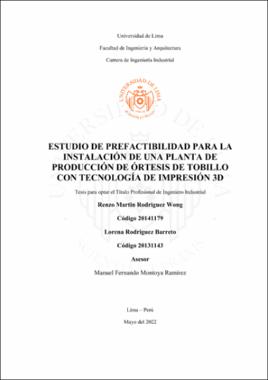Estudio de prefactibilidad para la instalación de una planta de producción de órtesis de tobillo con tecnología de impresión 3D

View/
Rodriguez-Rodriguez_Estudio-planta-impresión-3D.pdf
(application/pdf: 2.060Mb)
(application/pdf: 2.060Mb)
Date
2022Advisor(s)
Metadata
Show full item recordAbstract
El presente trabajo de investigación tiene como objetivo determinar si es viable y rentable la implementación de un taller de impresión de órtesis de tobillo en impresora 3D para deportistas, en un contexto, donde la actividad física ha ido ganando mayores seguidores y es importante mantener la capacidad máxima del deportista. Es por ello, que se plantea un producto de calidad, comodidad, seguridad, bajo precio y con servicio de atención personalizada.
El trabajo de investigación contiene ocho capítulos. En el primero, se presentan los aspectos generales de la investigación, como la problemática, los objetivos, los alcances, la justificación del tema, la hipótesis del trabajo, el marco referencial, etc.
En el segundo capítulo, se desarrolla el estudio de mercado para determinar la demanda potencial y demostrar si es conveniente ingresar al mercado. Así mismo, se analizará la oferta y la demanda, segmentando de manera adecuada el público objetivo. De esta forma, se encontró un resultado de 2 494 clientes para el primer año.
En los siguientes capítulos, se determina la localización del servicio utilizando el método de ránking de factores, y las dimensiones necesarias del taller teniendo en cuenta las relaciones entre el tamaño y el mercado, los recursos, la tecnología, la inversión y el punto de equilibrio. Se concluyó que, el taller se ubicaría en el distrito de San Borja dentro del departamento de Lima, y el tamaño de planta será determinado por la demanda.
En el quinto capítulo, se desarrolla la ingeniería del proyecto, donde se presentarán las especificaciones técnicas, los procesos para el servicio, la capacidad instalada, los requerimientos de recursos y la disposición para la instalación y correcto funcionamiento del centro. Luego, se presentará la organización administrativa.
En los últimos capítulos, luego de presentar la inversión total y los costos necesarios para la operación del servicio, se elaboran los presupuestos respectivos para realizar la evaluación, tanto económica como financiera. Finalmente, se realizará la evaluación social del proyecto. Finalmente, se confirmó la viabilidad del proyecto con un VANE y VANF positivo; un TIRE de 26,24% y un TIRF de 40,58%. The objective of this research work is to determine if the implementation of an ankle orthosis printing workshop in 3D printer for athletes is viable and profitable. In a context where physical activity has been gaining more followers and it is important to maintain the athlete's maximum capacity. That is why a product of quality, comfort, safety, low price and personalized service is proposed.
The research paper contains eight chapters. In the first one, the general aspects of the research are presented, such as the problem, the objectives, the scope, the justification of the topic, the hypothesis of the work, the referential framework, etc.
In the second chapter, the market study is developed to determine the potential demand and demonstrate whether it is convenient to enter the market. Likewise, both supply and demand will be analyzed, segmenting the target audience appropriately. In this way, a result of 2 494 clients was found for the first year.
In the following chapters, the location of the service is determined using the factor ranking method, and the necessary dimensions of the workshop taking into account the relationships between size and market, resources, technology, investment and the breakeven point. It was concluded that the workshop would be located in the district of San Borja within the department of Lima, and the size of the plant will be determined by demand.
In the fifth chapter, the engineering of the project is developed, where the technical specifications, the processes for the service, the installed capacity, the resource requirements and the disposition for the installation and correct operation of the center will be presented. Then, the administrative organization will be presented.
In the last chapters, after presenting the total investment and the costs necessary for the operation of the service, the respective budgets are prepared to carry out the evaluation, both economic and financial. Finally, the social evaluation of the project will be carried out. Finally, the viability of the project was confirmed with a positive VANE and VANF; an IRR of 26,24% and an IRR of 40,58%.
How to cite
Rodriguez Wong, R. M. y Rodriguez Barreto, L. (2022). Estudio de prefactibilidad para la instalación de una planta de producción de órtesis de tobillo con tecnología de impresión 3D [Tesis para optar el Título Profesional de Ingeniero Industrial, Universidad de Lima]. Repositorio institucional de la Universidad de Lima. https://hdl.handle.net/20.500.12724/16425Publisher
Universidad de LimaSubject
Collections
- Tesis [1167]
The following license files are associated with this item:

